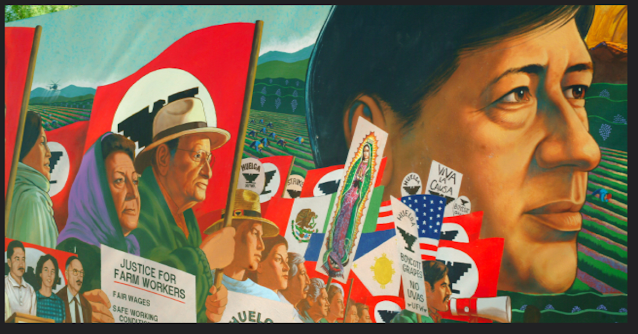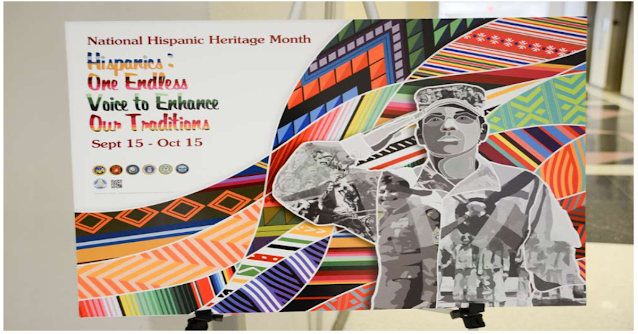Shaping America: The Story of Hispanic-Americans
The history of Hispanics in the United States is a great alliance that blends diverse cultures, languages and customs. From early Spanish explorers to today, Hispanics have left a significant mark on the nation's history, economy, arts and society. This article explores the complex history of Hispanics in the U.S., delving into their arrival, challenges, contributions, and lasting influence on the nation's multicultural fabric.
The term "Hispanic" refers to those with cultural or ancestral ties to Spanish-speaking regions, encompassing Latin America, Spain, and other Spanish-speaking areas. It includes people from various countries like Mexico, Colombia, Argentina, Spain, the Dominican Republic and more. It's crucial to understand that "Hispanic" primarily signifies linguistic and cultural connections and doesn't encompass the full diversity of backgrounds and ethnicities within these regions.
 |
| Cesar Chavez |
Some people prefer more specific terms like
"Mexican," "Puerto Rican," or "Cuban" to define
their heritage. Each of these nationalities possesses distinct cultural
traditions, histories and identities within the broader Hispanic or Latino
community. While they all fall under the Hispanic label, they maintain their
unique cultural characteristics and backgrounds.
💻 Table of Contents:
- Hispanic Americas: A Historical Overview
- Cultural Influence and Contributions
- Hispanic Labor: Driving Growth and Prosperity in the US Economy
- Civil Rights Struggles and Activism
- Political Representation and Influence
As of July 1, 2021, individuals of Hispanic origin constituted the largest racial or ethnic minority in the United States, accounting for 18.9% of the total population. The five largest Hispanic communities in the U.S. according to their country of origin, were Mexican (37.2 million), Puerto Rican (5.8 million), Salvadoran (2.5 million), Dominican (2.4 million) and Cuban (2.4 million). Additionally, three other origin groups with populations exceeding 1 million included Guatemalan (1.8 million), Colombian (1.4 million), and Honduran (1.1 million). Venezuelan populace in the U.S. witnessed a remarkable 169% growth between 2010 and 2021, increasing from 240,000 to 640,000 individuals. This represented the most rapid growth rate among Hispanic origin groups. Dominicans and Guatemalans followed with growth rates of 60% each.
Hispanic Americas: A Historical Overview
The arrival of Hispanics in what is now the United States dates back to the 16th century when Spanish explorers embarked on expeditions across the continent. Spanish colonization led to the establishment of settlements, including St. Augustine in Florida (1565) and Santa Fe in New Mexico (1610), making them among the oldest continuously inhabited European-founded cities in the United States.
 |
| Hispanic Map |
Spanish-speaking people have resided in North America since Spanish colonies were established there in the 16th century. By 1800, Spain had ruled over regions in North America, which now include Mexico and many southwestern U.S. states, for many centuries. Over half of all Hispanic Americans have Mexican roots. Some trace their heritage to areas in the U.S. that were once part of Mexico, like Texas, Arizona, New Mexico, and California. Other Mexican Americans have family roots that involve migration across the Mexico-U.S. border.
A pivotal moment in Latin American history occurred
with Christopher Columbus's arrival from Spain. It's worth noting that although
Columbus was Italian, his voyages were made under the Spanish flag,
significantly shaping both Spain and the Americas. On October 12, 1492,
Columbus and his crew reached the island of Guaraní. They were originally
seeking a route to Asia but stumbled upon a vast continent previously unknown
to Europeans.
Spanish explorers were pioneers in what's now the
United States. The first verified European landing in the continental U.S. was
by Juan Ponce de León in 1513. He arrived at a lush coast he named "La
Florida" and later served as the first governor of Puerto Rico. Ponce de
León first time arrived in the Americas as a "gentleman volunteer"
with Christopher Columbus on his second expedition in 1493.
 |
| Hispanic Heritage Month Poster |
The Spanish Empire extended its influence across the Caribbean Islands, half of South America, most of Central America, and a significant portion of North America. It is believed that, from 1492 to 1832, approximately 1.86 million Spaniards established themselves in the Americas. Additionally, another 3.5 million migrated during the post-colonial period from 1850 to 1950.
Cultural Influence and Contributions:
Hispanics have made significant contributions to American culture through their language, cuisine, music, dance, and artistic expressions. Spanish words and phrases have permeated the English language, and Latin American cuisines have become popular staples across the nation. Hispanic music genres, such as salsa, merengue, and reggaeton, have gained widespread recognition, while Hispanic artists, writers, and performers have left an indelible mark on American arts and entertainment.
Hispanics have left significant contributions on American culture, backing through their language, food, music, dance, and artistic expressions. Their influence continues to expand as Spanish ranks as the second most spoken language in the U.S. The states of Texas, California, and New Mexico have the largest Hispanic communities.
Some Spanish words like 'taco'
and 'burrito' have seamlessly integrated into everyday English. Spanish terms
and phrases have become embedded in the language, while Latin American cuisines
are now beloved across the nation. Hispanic music genres like salsa, merengue,
and reggaeton have gained broad recognition. Additionally, Hispanic artists,
writers, and performers have made an enduring impact on American arts and
entertainment.
 |
| Celebrate Hispanic Heritage Month |
Hispanic Labor: Driving Growth and Prosperity in the US Economy
Hispanic labor has been instrumental in the development of the United States' economy. From the early agricultural workers in the Southwest to the labor force in various industries today, Hispanics have contributed significantly to the nation's growth and prosperity. Hispanic entrepreneurs have established successful businesses, creating jobs and fostering economic vitality in their communities. Additionally, Hispanic-owned businesses have played a crucial role in the revitalization of urban neighborhoods and the promotion of small business growth.
From early farmworkers to diverse industries, Hispanics drive growth. They own successful businesses, create jobs, and boost communities. Hispanic-owned businesses rejuvenate neighborhoods and promote small business growth. In 2019, Hispanic households earned $1.2 trillion, paid $308.5 billion in taxes, including $196.5 billion federal taxes, and $112 billion state and local taxes. Even after taxes, Hispanic households had $910 billion in spending power. Businesses owned by Hispanics employ approximately 3 million workers.
Civil Rights Struggles and Activism:
Hispanics have faced various challenges and fought for civil rights throughout American history. From discriminatory laws and segregation to unequal treatment and limited opportunities, Hispanics have persevered against adversity. Hispanics have fought for civil rights, enduring discrimination and limited opportunities. Figures like Cesar Chavez, Dolores Huerta, and Sylvia Mendez were key in advocating for labor rights, education equality, and racial justice. Their activism advanced civil rights and Hispanic contributions. The Chicano civil rights movement in the 1960s, led by Chavez, Tijerina, and others, addressed labor, land, and education issues.
 |
| Chicano Movement |
Political Representation and Influence:
Hispanic political representation and influence have grown over the years. Hispanic leaders have held prominent positions in government, both at the local and national levels. Notably, the appointment of the first Hispanic Supreme Court Justice, Sonia Sotomayor, in 2009 marked a significant milestone.
Hispanics have also played pivotal roles in shaping policies and advocating for issues such as immigration reform, education reform, and healthcare access. Mexican Americans and Puerto Ricans tend to favor the Democratic Party, while Florida Cuban Americans strongly support Republicans while their New Jersey co-ethnics consistently vote Democratic.
Conclusion:
The history of Hispanics in the United States is evidence to their spirit, contributions, and lasting impact on the nation. From early Spanish explorers to the present day, Hispanics have left an enduring mark on American culture, economy, politics, and society. Their influence can be observed in the arts, language, cuisine, workforce, civil rights movements, and political representation.
The rich diversity and cultural heritage of the Hispanic community continue to shape and enrich the United States, fostering a vibrant multicultural society. By acknowledging and celebrating the history and contributions of Hispanics, we honor their legacy and recognize the invaluable role they have played in shaping the nation we know today.





